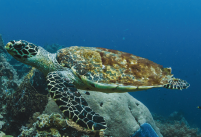Saving Sea Turtles
For more than 100 million years sea turtles have covered vast distances across the world’s oceans, filling a vital role in the balance of marine habitats. Seven different species of sea (or marine) turtles grace our ocean waters, from the shallow sea grass beds of the Indian Ocean, to the colorful reefs of the Coral Triangle, and even the sandy beaches of the Eastern Pacific. WWF’s work on sea turtles focused on five of those species: green, hawksbill, loggerhead, leatherback and olive ridley. Human activities have tipped the scales against the survival of these ancient mariners. Nearly all species of sea turtle are classified as endangered. Slaughtered for their eggs, meat, skin and shells, sea turtles suffer from poaching and over-exploitation. They also face habitat destruction and accidental capture in fishing gear. Climate change has had an impact on turtle nesting sites as well. It changes sand temperatures, which then affects the sex of hatchlings. WWF is committed to stopping the decline of sea turtles and work for the recovery of the species. We work to secure environments in which both turtles—and the people that depend upon them—can survive into the future. Sea turtles are a fundamental link in marine ecosystems. They help maintain the health of sea grass beds and coral reefs that benefit commercially valuable species such as shrimp, lobster and tuna. Sea turtles are the live representatives of a group of reptiles that have existed on Earth and traveled our seas for the last 100 million years. Turtles also have a major cultural significance and tourism value. WWF aims to reduce turtle bycatch by working with fisheries to switch to more turtle-friendly fishing hooks (“circle” hooks). WWF runs an international competition, known as Smart Gear, to attract creative new ways to solve bycatch problems and to advance the best of those ideas. We track turtle movements using satellites to help prevent future interactions between fisheries and turtles.

